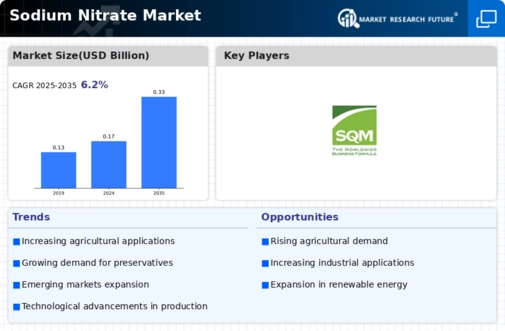Market Trends
Key Emerging Trends in the Sodium Nitrate Market
The Sodium Nitrate market is experiencing notable trends and growth opportunities driven by its diverse applications across industries such as agriculture, chemical manufacturing, and pharmaceuticals. Sodium nitrate, a compound composed of sodium and nitrate ions, is commonly used as a fertilizer, oxidizing agent, and precursor for various chemical compounds. One prominent trend in the Sodium Nitrate market is the increasing demand for agricultural fertilizers containing sodium nitrate as a source of nitrogen. As global food demand continues to rise, there is a growing need for fertilizers that can improve crop yields and enhance soil fertility. Sodium nitrate-based fertilizers provide readily available nitrogen to plants, promoting healthy growth and increasing agricultural productivity, thus driving the growth of the Sodium Nitrate market in the agriculture sector.
Moreover, the Sodium Nitrate market is influenced by the demand for nitric acid, a key chemical compound used in the production of fertilizers, explosives, and various industrial chemicals. Sodium nitrate is a primary feedstock for the production of nitric acid through the Ostwald process, which involves the oxidation of ammonia. As industries such as agriculture, mining, and manufacturing continue to grow, there is a rising demand for nitric acid and its derivatives, driving the demand for sodium nitrate as a raw material. Additionally, sodium nitrate is used in the production of nitrite salts, which find applications as corrosion inhibitors, food preservatives, and pharmaceutical intermediates, further contributing to the growth of the Sodium Nitrate market in the chemical manufacturing and pharmaceutical sectors.
Another key trend in the Sodium Nitrate market is the increasing use of sodium nitrate as a heat transfer fluid in solar power plants. Concentrated solar power (CSP) plants use molten salt as a heat transfer fluid to store and transport thermal energy generated by solar collectors. Sodium nitrate, due to its high thermal stability and heat capacity, is commonly used as a molten salt in CSP systems, enabling efficient energy storage and delivery for electricity generation. With the growing adoption of renewable energy sources such as solar power, there is a rising demand for sodium nitrate as a heat transfer fluid, driving the growth of the Sodium Nitrate market in the renewable energy sector.
Furthermore, the Sodium Nitrate market is influenced by regulatory policies and environmental initiatives aimed at promoting sustainable agriculture practices and reducing greenhouse gas emissions. As governments implement regulations to limit the use of nitrogen-based fertilizers and mitigate nitrogen pollution in water bodies, there is a growing interest in alternative nitrogen sources such as sodium nitrate, which offers lower leaching potential and reduced environmental impact compared to traditional fertilizers. Additionally, initiatives to promote renewable energy sources and reduce reliance on fossil fuels drive investment in CSP technology and the demand for sodium nitrate as a heat transfer fluid, supporting the growth of the Sodium Nitrate market in the renewable energy sector.
The COVID-19 pandemic has impacted the Sodium Nitrate market, causing disruptions in supply chains, production, and demand across industries. However, the pandemic has also underscored the importance of food security, renewable energy, and sustainable agriculture practices, driving greater investment in agricultural inputs, chemical manufacturing, and renewable energy infrastructure. As economies recover and industries adapt to the new normal, the demand for sodium nitrate is expected to rebound, driven by the need for fertilizers, chemical intermediates, and heat transfer fluids in agriculture, manufacturing, and renewable energy sectors.


 Source: Secondary Research, Primary Research, Market Research Future Database and Analyst Review
Source: Secondary Research, Primary Research, Market Research Future Database and Analyst Review

Leave a Comment